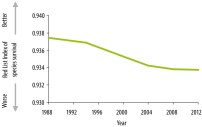
Between 2005 and 2012, 25 species in Africa were uplisted to higher categories of threat in the IUCN Red List. Yet, only seven species were downlisted to lower threat categories. Among those placed in higher threat categories are emblematic species such as Bateleur Terathopius ecaudatus, Martial Eagle Polemaetus bellicosus and several species of vulture. Of 11 vulture species found in Africa, seven (including five of the six species endemic to Africa) are listed as globally threatened. Worryingly, five of these species joined the Red List of threatened species only in the last seven years. For instance, Hooded Vulture Necrosyrtes monachus, a species that has historically been widespread in Africa, was listed as Endangered in 2011.

More bird species in Africa are being uplisted to higher categories of threat than are being downlisted to lower categories. This indicates that more species are slipping closer to extinction. There is an urgent need to identify and adequately protect species with a high risk of extinction before their populations become too small to be managed effectively.
For example, there has been a steep decline in the number of vultures in West Africa (over 95%) in the last four decades. This is principally the result of habitat loss and degradation and the decline of wild ungulates, especially antelopes, which are a major source of food. In East Africa, large-scale vulture mortality has also resulted from the misuse of chemicals. For instance, in Kenya, 187 vultures died from Furadan poisoning near Athi River in 2004: White-backed Vultures Gyps africanus were the most affected, but Ruppell’s Vulture Gyps rueppellii and Lappet-faced Vulture Torgos tracheliotos, were also victims. In South Africa, unsustainable trade in vulture parts for traditional purposes is an additional major threat.
Related Case Studies in other sections
Related Species
References
Compiled: 2013
Recommended Citation:
BirdLife International (2013)
The status of Africa’s birds is deteriorating.
Downloaded from https://datazone.birdlife.org/the-status-of-africa’s-birds-is-deteriorating on 22/12/2024